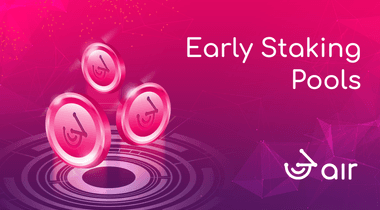Table Of Contents
One of the hottest topics in 3air right now are the Access Point Nodes. Why? 3air’s Access Point Nodes will allow decentralized broadband internet sharing and allow users to earn revenue that – up until now – was reserved only for telecom operators.
What is an Access Point Node
An Access Point Node (APN) in 3air is a Wi-Fi device that connects to other Access Point Nodes to create a seamless Wi-Fi network which users can connect to. Once you join the network, you can use the available data to browse the internet.
You can think of an Access Point Node as an extremely powerful router that can create a Wi-Fi mesh network with other routers. It is similar to the network you set up in your home, except that APNs are far more powerful and have a higher throughput and reach. An APN can have a reach of about 250 meters and can handle more than 1000 users connected to it simultaneously.
The connection to an APN is almost the same as to a public Wi-Fi network. In a sense, Access Point Operators (APOs) will form a public Wi-Fi network, allowing users to connect to the internet, while the APOs earn revenue from letting people use their APN.
How to participate in the 3air Access Point Network?
There are 6 key parties in the APN ecosystem:
- 3air, providing the platform used to manage all other parties
- The ISP (Internet Service Provider) providing the internet bandwidth. An ISP needs to have a license to provide internet in a certain region.
- The High-End User connecting to the ISP and having a high-speed broadband internet connection with a sharing license.
- The Access Point Node Operator who takes the extra bandwidth from the user and operates the APN to allow other end users to connect to the internet through it.
- The Staking Insurer who stakes his tokens in the APN to provide a financial incentive for smooth and secure APN operation.
- The end user connecting to the APN and using its services.
The 3air platform
The 3air platform has the functionality to connect all the key players within the 3air APN ecosystem. It needs to ensure that the ISPs have a proper license, provide the APN hardware and software and provide the platform for easy staking of 3air tokens into the APNs. It also has the function of overseeing the quality of the provided services and managing any malicious actors. The 3air platform also makes sure that revenue is distributed correctly.
Additionally, the 3air platform serves to align and connect different ISPs into a seamless roaming experience for the 3air user, covering multiple regions across the world.
The ISPs
Although centralized, the ISPs play a key role in the 3air APN ecosystem. As long as the internet is a regulated commodity, ISPs are needed to connect to the undersea cables and distribute the available bandwidth to the end users in a licensed and regulated manner. ISPs are needed to provide last mile connectivity for end users and for the mash network.
As regulated entities, ISPs need to ensure minimum standards of bandwidth provision and rely on the 3air platform to enable compliance with the end user.
As of now, 3air has a special agreement with K3 telecom as the ISP of choice, providing broadband services to the 3air users and connected APNs.
ISPs are regionally bound with their infrastructure and their licenses. After the initial testing period, 3air will open its platform to other ISPs, expanding into multiple regions globally and providing a seamless roaming experience for the 3air user.
The High-End user
The High-End user connects to the ISP directly through a high-speed internet connection of choice. Each ISP may provide different connectivity options such as optics cable, coax or 5G. In the case of K3 connectivity, a super high-speed connection is available through a proprietary wireless connection, providing up to 1 Gbps of bandwidth.
High-End users are locally bound to the availability of 3air partner connectivity and have their connection end points at their premises.
The High-End user may make her infrastructure endpoint and unused bandwidth available for the APN to connect to and share. Once this happens, 3air marks the physical location of this newly available internet endpoint and provide geolocation data to other 3air users, especially to potential APOs that can connect to a new bandwidth source and expand the network.
There might and will be an overlap in the High-End users and APOs, as they may opt in to join in both positions. In special cases, ISPs might run their own APNs in key public areas that regular users might not have physical access to.
The APOs
The APOs install and operate the APNs. APNs are provided by 3air and the necessary firmware to run a node is preinstalled. With time, 3air may provide exact hardware requirements so that the end user is able to buy Access Points (APs) on the open market and flash them with 3air provided firmware to connect to the 3air network.
Mounting and running the APN will require minimal technical knowledge.
Each APN is issued an operator NFT that serves to identify the APN and stake 3air tokens to it. An identifier in a decentralized node network is necessary to identify and sanction bad actors and reward good nodes with a revenue split.
Anyone will be able to read the NFT data from chain and decide if they wish to participate in any of them as Staking Insurers.
Once an APO acquires an AP, they will need to mount it on a strategic place for others to be able to connect to it. 3air will issue guidelines and instructions for mounting APs. 3air will also provide hands-on help through their local ISP partners to ensure best network outcomes in the early stages of the 3air bandwidth sharing project.
An AP needs to be connected to a high-speed internet source or to another AP to be able to relay the bandwidth connection.
Once a mounted AP is ready to start connecting new users to it, a minimum stake needs to be acquired. Once the minimum stake is acquired and the AP is connected to the 3air network, it becomes an APN.
The minimum stake amount will be set after the successful test run and can be met by the APOs themself or by token delegation. A minimum personal stake from the APO will be required to ensure incentive alignment (based on the fundamentals of Game Theory).
Due to supply chain issues in the microchip sector, the current costs to acquire an AP range from 1,300 USD to up to 3,800 USD. To kick off the initial 3air network, 3air may subsidize the APs for staked 3air tokens.
The Staking Insurer
The APN network is a living system, meaning some parts might fail due to hardware failure or other reasons. In case of hardware failure, the AP needs to be repaired or replaced. Staked tokens are used to cover the cost of such unfortunate events. It needs to be noted that technical requirements for 3air APs are high, making them robust and unlikely to fail in any weather conditions or harsh environmental conditions.
However, in such an unlikely event the costs will be shared with all current stakeholders proportionally to their stake.
The Staking Insurer (SI) will be presented with a list of available APNs for staking and their data including:
- Geolocation
- Market potential in form of estimated end users in the area
- Current APN stats
- Nearby APN stats
- APN history
- Current staked tokens
The SI will then be able to delegate their stake to the APN of their choice and as such participate in its operations.
If an SI wishes to unstake their tokens, they will be able to do this on an 8-week basis.
The End User
The only technical thing that the End User is in touch with is their own Wi-Fi device connectivity. The Wi-Fi mesh network will follow all Wi-Fi standards and will be compatible with any Wi-Fi enabled device.
At the time of connecting, the APN will check the End User’s connection legibility by verifying their connectivity NFT ownership. Additionally, a legacy bridge to traditional paid public Wi-Fi usage will be provided at a slightly higher cost to incentivize and drive NFT-enabled connectivity usage.
Revenue sharing
In the past, only telecom businesses were able to earn revenue from broadband usage. 3air allows every APO to earn a part of the revenue of this highly profitable business.
All the key players within the system need to be rewarded properly. The End User is rewarded with easy access to stable, fast and affordable internet. The rest of the ecosystem participants are compensated with a revenue split for their work in building, maintaining, and operating the required infrastructure.
The right split will be determined after a successful test run on a larger scale that will provide the necessary data. Additionally, the revenue split will need to be adjusted to local markets as the initial cost of internet for an ISP may greatly vary between regions.
To ensure wide-scale adoption and expansion, some less frequently used nodes will need to be subsidized to allow for their operations. This requires careful consideration so as to avoid subsidizing APNs that are not used or of no strategic value.
Additional consideration needs to be given to a revenue split between the APNs with regard to their usage and stake. A diminishing return for staked tokens needs to be implemented as to prevent centralization of staking power in a single APN and this APN earning most of the revenue.
Also, the APNs need to reward their APO, Staking Insurers (SIs), High-End providers and in the end the ISP. The ISP and the High-End user need to be compensated by any APN that directly connects to them, as the SIs and APOs will earn revenue only through the APN they are staking with or operating.
In a system as complex as this in which there is a network of nodes each connecting to every other node, and through each node to multiple broadband sources, a highly effective analytics system needs to be in place with big-data analytics and statistical modeling that will help create the fairest revenue distribution.
AP technical guidelines
- Minimum requirements for 3air APs are:
- Wi-Fi Standards: IEEE 802.11a/b/g/n/ac/ax
- Peak PHY Rates: 2.4 GHz: 1148 Mbps
- Client Capacity: 1024 clients per AP
- SSID: 31 per AP
- 5GHz: 36-64, 100-144, 149-165
- Operating Temperature: -40°C (-40°F) to 65°C (145°F)
- Operating Humidity: Up to 95%, non-condensing
Current state of the 3air APN ecosystem
As of September 2022, the 3air APN ecosystem is still under development. We’re currently running a lab environment with 3 nodes and one broadband source. After a successful lab version is completed and fully operational, we will deploy the nodes in a small-scale public environment in Sierra Leone which will still be fully under 3air and K3 control.
The next step is to test the APNs in a larger scale public, but controlled environment. We plan to deploy around 80 APNs in The Democratic Republic of the Congo (DRC) on the 20km long road leading from the airport to the center of Kinshasa, DRC’s capital city. More than 1 million people walk along this road every day, which provides an ideal large-scale testing ground with huge revenue potential.
At that point, 3air and K3 will mount and run the APOs while offering first user participation in providing additional staked tokens. This is also when the first revenue split will begin.
After a successful testing round in DRC is completed, the project will enter the full public beta phase and all functionalities will be released for anyone to participate.
Useful links:
Everything you need to know about K3 Last Mile
Why is blockchain necessary for the 3air platform










